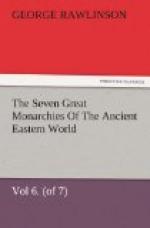to a wholly different ethnic family. But, in
the first place, the existence of isolated nationalities,
detached fragments of some greater ethnic mass, embodied
amid alien material, is a fact familiar to ethnologists;
and, further, it is not at all certain that there
were not other Turanian races in these parts, as,
for instance, the Thamanasans. Again, it is said
that the Parthians show their Arian extraction by their
names; but this argument may be turned against those
who adduce it. It is true that among the Parthian
names a considerable number are not only Arian, but
distinctly Persian—e.g., Mith-ridates, Tiridates,
Artabanus, Orobazus, Rhodaspes—but the
bulk of the names have an entirely different character.
There is nothing Arian in such appellations as Amminapes,
Bacasis, Pacorus, Vonones, Sinnaces, Abdus, Abdageses,
Gotarzes, Vologeses, Mnasciras, Sanatroeces; nor anything
markedly Arian in Priapatius, Himerus, Orodes, Apreetseus,
Ornos-pades, Parrhaces, Vasaces, Monesis, Exedares.
If the Parthians were Arians, what account is to be
given of these words? That they employed a certain
number of Persian names is sufficiently explained
by their subjection during more than two centuries
to the Persian rule. We are also distinctly told
that they affected Persian habits, and desired to
be looked upon as Persians. The Arian names borne
by Parthians no more show them to be Arians in race
than the Norman names adopted so widely by the Welsh
show them to be Northmen. On the other hand,
the non-Arian names in the former case are like the
non-Norman names in the latter, and equally indicate
a second source of nomenclature, in which should be
contained the key to the true ethnology of the people.
The non-Arian character of the Parthians is signified,
if not proved, by the absence of their name from the
Zendavesta. The Zendavesta enumerates among Arian
nations the Bactrians, the Sogdians, the Margians,
the Hyrcanians, the Arians of Herat, and the Chorasmians,
or all the important nations of these parts except
the Parthians. The Parthian country it mentions
under the name of Nisaya or Nisaea, implying apparently
that the Parthians were not yet settled in it.
The only ready way of reconciling the geography of
the Zendavesta with that of later ages is to suppose
the Parthians a non-Arian nation who intruded themselves
among the early Arian settlements, coming probably
from the north, the great home of the Turanians.
Some positive arguments in favor of the Turanian origin
of the Parthians may be based upon their names.
The Parthians affect, in their names, the termination
-ac or -ah, as, for instance, in Arsac-es, Sinnac-es,
Parrhaces, Vesaces, Sana-trseces, Phraataces, etc.—a
termination which characterizes the primitive Babylonian,
the Basque, and most of the Turanian tongues.
The termination -geses, found in such names as Volo-geses,
Abda-geses, and the like, may be compared with the
-ghiz of Tenghiz. The Turanian root annap, “God,”
is perhaps traceable in Amm-inap-es. If the Parthian
“Chos-roes” represents the Persian “Kurush”
or Cyrus, the corruption which the word has undergone
is such as to suggest a Tatar articulation.




